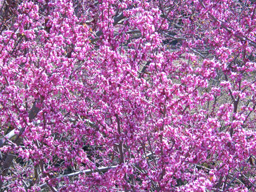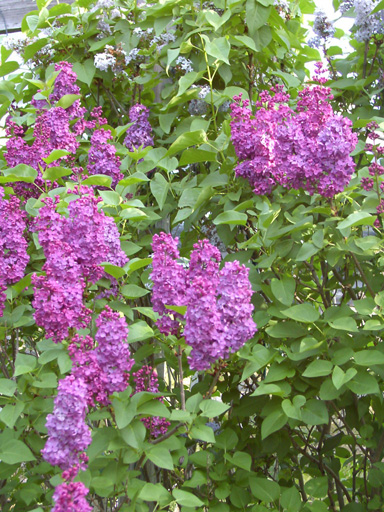Deciduous Flowering Shrubs
Sentimental Favorites!
Published in the Davis Enterprise, Feb. 22, 2001
"What is that shrub I see blooming right now--it's a mass of red flowers?"(or pink, red, or white...and it's only February!)
"I just moved here from the mid-west. Doesn't anyone grow Forsythia here?"
"What's that shrub that's got the magenta flowers in the Arboretum?"
"Do you sell Bridal wreath? How about Mock orange? Beauty bush? Pearl bush? Deutzia? Weigela?"
"My mother grew lilacs back where I grew up. Can I grow them here?"
These are all deciduous flowering shrubs, familiar to gardeners from colder climates (deciduous means they lose their leaves in the winter). Your grandmother grew them, and prized them for the flowers they provided in the late winter and spring. They are very common in landscapes in the midwest, New England, and the Pacific Northwest, but nearly all of them grow well here without special attention. They make a great addition to the background of shrubs in your backyard, and then delight you with spectacular bloom for a few weeks each spring. Many of them are sentimental favorites.
Using Shrubs in the Landscape
I've been in a lot of back yards recently where the original owners failed to plant the mix of evergreen and deciduous shrubs that give the backbone of the landscape: privacy, texture, and a softening of the blank walls and fences of our suburban landscape. It's the combination of shrubs you choose that "anchor" the other landscape elements. Deciduous flowering shrubs, mixed into this combination, can provide some dramatic seasonal changes.
Chaenomeles--Flowering Quince
That shrub you see blooming now is Chaenomeles japonica, the Flowering quince. Available in shades of red, pink, coral, and white, it is the first shrub to bloom in the late winter. One variety, 'Toyo Nishiki', even boasts blooms of red, pink, and white all on the same plant and the same branch! There are varieties that only grow to 3-4', and others that exceed 6'. Cut branches can be brought into the house for flower arrangements, and will last for over a week. If you're lucky enough to get fruit on your Chaenomeles, it makes a wonderfully fragrant and beautiful jam (my wife seeks out Chaenomeles plants with fruit). Chaenomeles is easy to grow in sun or shade. It looks best if it isn't watered more than once a week, and requires no pruning. Iron deficiency is common if it is watered more often.
Forsythia--Harbinger of Spring!

Next up--blooming as early as next week-- is Forsythia Shown here blooming in March. People from colder climates know this as the harbinger of spring, with its brilliant golden yellow flowers. This is a big, rangy shrub with medium green foliage and an arching habit. Stick it in behind large evergreen shrubs to enjoy the late winter blooms. Prune it for size control after it finishes blooming. This is a good rule of thumb for deciduous flowering shrubs: prune just after they finish blooming, and mainly for size control.
Western Redbud

That shrub that's got the magenta flowers in the Arboretum is Western redbud: Cercis occidentalis. [Flowers and Foliage]Spectacular for a couple of weeks in March, this native plant is a little fussy. Being adapted to our rainfall cycles, it is sensitive to over-watering in the summer here, preferring only occasional deep soakings from May through October. Western redbud has multiple trunks but can be trained as a small tree. The eastern relatives, Cercis canadensis varieties, need summer watering and may show some leaf damage after extreme summer heat here. These are larger and more naturally tree-like in their growth habits.
Spiraea
Several members of the genus Spiraea are called Bridal wreath, because they have pure white flowers and bloom between April and June. Other Spiraeas bloom in the summer, and some have pink flowers. All of them are very easy to grow, and most have an informal, arching growth habit. S. vanhouttei, one of the best, has grey-green foliage, bright yellow fall color, and is a mass of white flowers in April. S. prunifolia blooms in February. There's only one species that I don't like to sell: S. bumalda, with the most familiar variety being 'Anthony Waterer.' This group is sensitive to our hard water, and shows chronic iron deficiency from mid-summer to fall. Landscapers keep installing this one in mass plantings because of its low growth habit, but no amount of iron fertilizer seems to correct the anemic late-summer appearance.
Mock orange
My grandmother was from Boston, and 50 years in South Dakota didn't dilute her accent: we always had "hahd sauce" with our Christmas "puddin" (hard sauce is a sweet creamy sauce which cools on the pudding to form a sweet icing). Whenever I hear that accent, and they're asking about "Mock orange," I know they don't mean our Pittosporum or Choisya, two other plants we call Mock orange. Since they're easterners, they must mean Philadelphus! This shrub grows to 8' or more, with medium green foliage. A gangly growth habit, but it redeems itself with masses of white flowers that have a spicy citrus scent. Again, it belongs in the back of the "shrubbery" (Monty Python fans take note: I am indeed a "shrubber!").
Other old favorites
There are several other old favorite deciduous flowering shrubs. Deutzias bloom in April - May, and are mostly very large shrubs with pure white flowers and soft green foliage. 'Nikko' is a compact grower to about 2' tall and 2' across--a great addition to the perennial border. Pearl bush, Exochorda macrantha 'The Bride,' is a similar shrub that grows to about 4'; E. racemosa grows to 10' +. Beauty bush, Kolkwitzia amabilis, is another big flowering shrub to 10 - 12', with a graceful arching habit and clusters of pink flowers in May. Weigela has lovely pink flowers and is popular in Sacramento, but is chronically iron-deficient in Davis and Woodland due to our hard water, so it isn't recommended here.
Lilacs!

The last of the deciduous flowering shrubs that blooms in the spring is the familiar Lilacs! Syringa. S. vulgaris is the fragrant lilac, and there are hundreds of varieties. The French hybrids are the most fragrant, but we live just on the edge of where these get enough winter chilling to bloom reliably. Plant them in full sun and away from the house where they will get as cold as possible in the winter. In a mild winter you can dump ice cubes on them a few times to encourage proper flower development! Descanso hybrids were bred for warmer winter climates and bloom more reliably, but they aren't as fragrant. Syringa is rare in that it actually prefers alkaline soil. There are several other species, but most aren't common in the trade.
Mix them with evergreens....
Most of these shrubs don't grow where I grew up (La Jolla, on the northern coast of San Diego) because it just doesn't get cold enough there in the winter. So when I moved here I fell in love with them and planted lots of them. Then I began to realize that the bare winter appearance was a drawback. So, use these mixed with evergreen shrubs that look good in the winter: Nandina, Cotoneaster, Coleonema, Juniper 'Old Gold', Viburnum tinus 'Spring Bouquet' Then you can enjoy the special spring blooms, and they can blend into the "shrubbery" for the rest of the growing season.
© 2008 Don Shor, Redwood Barn Nursery, Inc., 1607 Fifth Street, Davis, Ca 95616
www.redwoodbarn.com
Feel free to copy and distribute this article with attribution to this author.
Click here for Don's other Davis Enterprise articles
